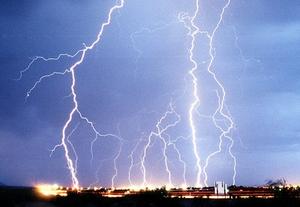DisastersU.S. to face an increased risk of severe thunderstorms
Severe thunderstorms, often exhibiting destructive rainfall, hail and tornadoes, are one of the primary causes of catastrophic losses in the United States. In 2012, eleven weather disasters in the United States crossed the billion-dollar threshold in economic losses. Seven of those events were related to severe thunderstorms. New climate analyses indicate that global warming is likely to cause a robust increase in the conditions that produce these types of storms across much of the country over the next century.

Study notes that we will see more frequent thunderstorms // Source: commons.wikimedia.org
In 2012, eleven weather disasters in the United States crossed the billion-dollar threshold in economic losses. Seven of those events were related to severe thunderstorms.
New climate analyses led by Stanford scientists indicate that global warming is likely to cause a robust increase in the conditions that produce these types of storms across much of the country over the next century. Severe thunderstorms are one of the primary causes of catastrophic losses in the United States and often exhibit the conditions that generate heavy rainfall, damaging winds, hail and tornadoes.
A Stanford University release reports that sparse historical data describing the atmospheric conditions that cause severe thunderstorms has limited scientists’ ability to project the long-term effects of global warming on storm frequency. Using a complex ensemble of physics-based climate models, however, researchers led by Noah Diffenbaugh, an associate professor of environmental Earth system science at Stanford, have produced the most comprehensive projections of severe storm conditions for the next century.
Scientists have identified two main ingredients involved in generating a severe thunderstorm. The first is that the atmosphere must contain a significant amount of what scientists call convective available potential energy (CAPE), created as the air in the low atmosphere warms. The warm air rises, carrying with it moisture to higher altitudes.
To transform into a severe thunderstorm, CAPE must also interact with strong vertical wind shear — essentially a moving wind current that organizes the atmospheric energy and moisture such that it can sustain a storm.
Climate researchers have previously hypothesized that global warming will increase CAPE and cause an overall decrease in wind shear, which created uncertainty about the net effect.
The new climate model experiment that Diffenbaugh and his co-authors analyzed, called the Coupled Model Intercomparison Project (CMIP5), confirms these competing effects, but in a different way than previously believed.
Although the climate model experiment does indicate an overall decrease in the average amount of wind shear, the researchers found that the bulk of that decrease occurs on days that produce levels of CAPE that are much lower than is normally seen during severe storms.
The net effect is that the increases in CAPE on other days drive increases in the occurrence of severe thunderstorm environments.
“We’re seeing that global warming produces more days with high CAPE and sufficient shear to form severe thunderstorms,” said Diffenbaugh, who is also a senior fellow at the Stanford Woods Institute for the Environment.
